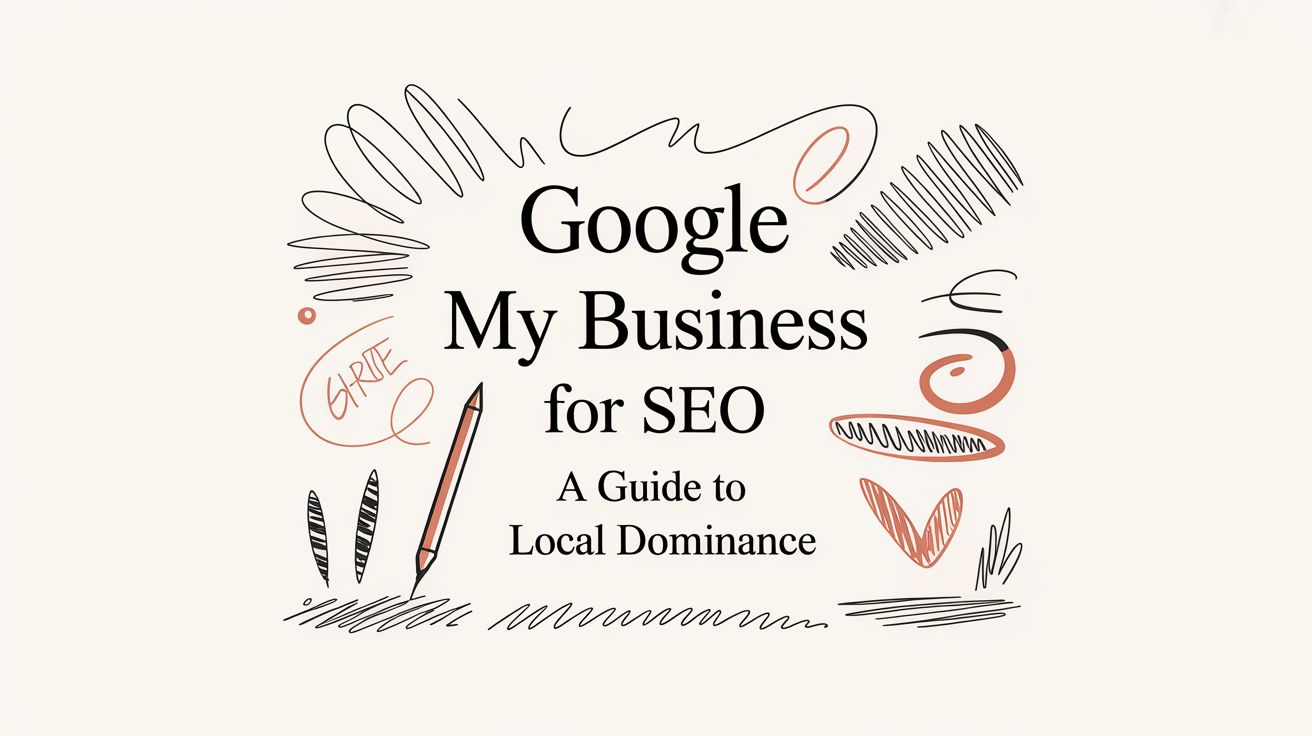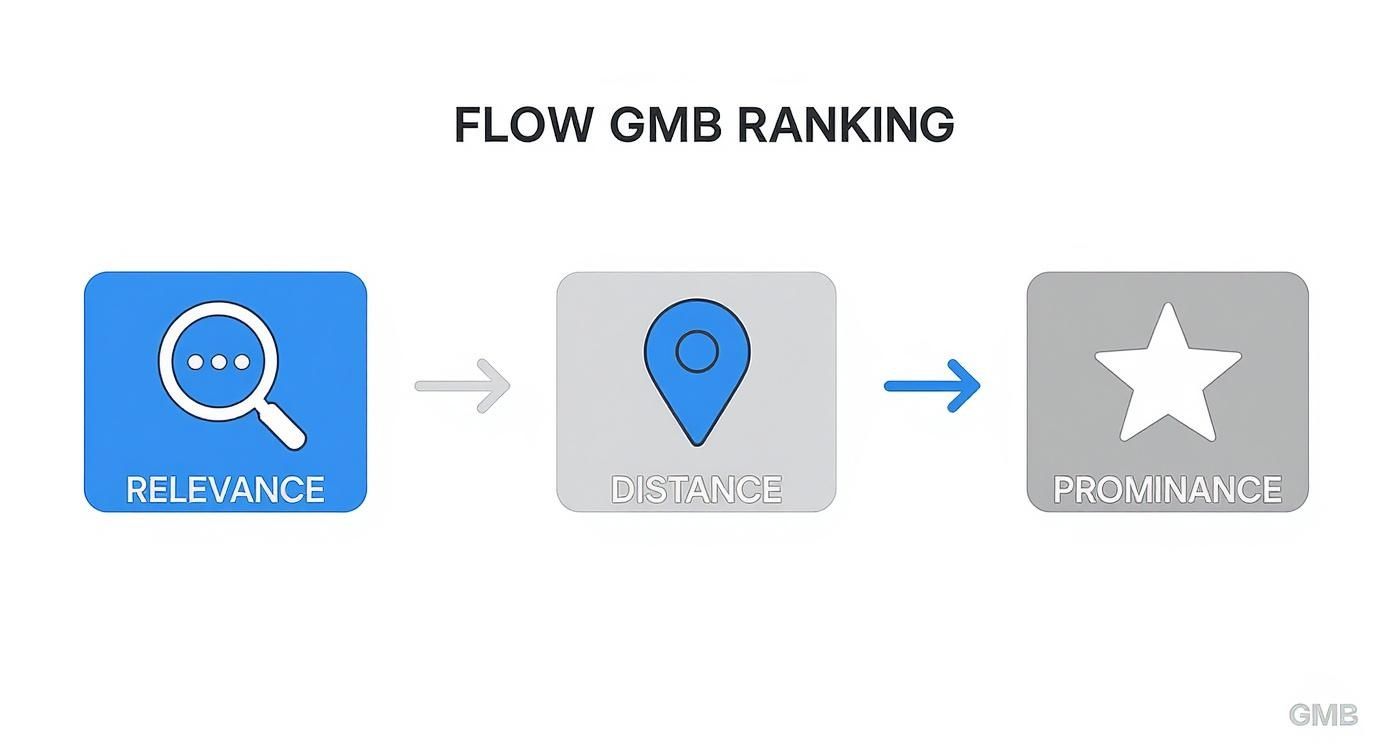Google My Business for SEO A Guide to Local Dominance

Your Google Business Profile isn't just another online listing—it's the heart and soul of your local SEO strategy. It’s what directly puts you in front of customers on Google Maps and in the 'Local Pack', which is exactly where most people decide who to call or where to go. Honestly, if you're a local business, treating your profile as an afterthought is no longer an option. It's essential. For a seamless way to manage your customer feedback and boost your online reputation, check out our platform at https://goodkudos.com.
Why Your Google Business Profile Is Your Strongest Local SEO Asset
Think of your Google Business Profile as your digital front door. Long before someone even thinks about clicking through to your website, they've already seen your opening hours, phone number, photos, and—most importantly—your reviews. It’s often the very first impression you make. A profile that’s filled out and actively managed doesn't just give information; it builds instant trust.
This is about more than just existing online; it's about competing for prime digital real estate.
When someone searches for "plumber near me" or "best coffee in Manchester," Google doesn't just pull up a random list. It scans millions of profiles to feature the most relevant, trusted businesses in the 'Local Pack'—that golden box of three businesses you see at the top of the search results. Getting a spot there can be a complete game-changer, driving a huge increase in calls, website visits, and people walking through your door.
Here’s a look at what a customer typically sees, and it really drives home how vital that first impression is.
The layout puts photos, reviews, and core details front and centre. It’s your most direct line to a potential customer, so you’ve got to make it count.
How Google Ranks Your Profile
To get your profile showing up, you need to think like Google's local algorithm. It’s not a big mystery; it mainly comes down to three things: relevance, distance, and prominence. With over 46% of all Google searches in the UK having local intent, how your profile performs is critical.
Google is trying to figure out how well your business matches what the searcher wants (relevance), how close you are to them (distance), and how established and well-regarded your business is (prominence). If you want to dig a bit deeper into the data, wiserank.co.uk has some great insights.
This means every single field in your profile is sending a signal. Your business categories tell Google you’re relevant. Your address pinpoints your distance. Your reviews, photos, and updates all build your prominence. A profile that’s firing on all cylinders is constantly sending the right signals, turning your listing into a powerful customer magnet.
A powerful way to boost your profile’s prominence is by encouraging satisfied clients to share their feedback on Google. By showcasing glowing testimonials you've collected on platforms like Good Kudos, you can inspire customers to add their own positive reviews, strengthening your social proof directly where it counts. Get started today at https://goodkudos.com.
Getting The Fundamentals Right: Your Profile Setup and Verification
If you want to get anywhere with local SEO, your Google Business Profile needs a flawless foundation. The initial setup and verification aren't just boxes to tick; they're the very first signals you send Google about your business's legitimacy and relevance. Get these details wrong, and you risk confusing both the algorithm and your potential customers right from the start.
First things first, you need to either create a new profile or claim an existing one. If your business has been around for a while, it’s pretty likely Google has already auto-generated a basic listing for it. Just do a quick search for your business name and location to check. Whether you're creating or claiming, the goal is the same: to get full control so you can start optimising.
Choosing Categories and Nailing NAP Consistency
One of the most critical decisions you'll make is selecting your business categories. You get to choose one primary category and then add several secondary ones. Don't be vague here. Be specific. If you're a "Plumbing Contractor" who also offers "Drain Cleaning Services," make sure you use both. This directly tells Google which search queries your business is a good match for.
Next up is the non-negotiable rule of NAP consistency. Your Name, Address, and Phone number must be identical everywhere online—from your website to every local directory you're listed on. Even a tiny variation, like using "St." on your profile but "Street" on your website, can create confusion and chip away at Google's trust in your data. It sounds small, but it really matters.
This infographic breaks down the core factors Google uses to rank local businesses, which really highlights why a solid, consistent setup is so important.

As you can see, the data in your profile directly fuels Google's ability to figure out how relevant you are for local searches and how close you are to the searcher.
Navigating the Verification Process
Once you’ve filled in your core details, Google needs to confirm your business is real and is actually located where you claim it is. This is the verification step, and honestly, it can sometimes be a bit of a hurdle.
You’ll typically see a few options:
- Postcard by mail: This is the old-school method. Google sends a postcard with a verification code to your business address. Simple, but slow.
- Phone call or text: An automated system calls or texts a code to your business phone number. Much faster.
- Email: This is available for certain businesses, where a code is sent straight to your inbox.
- Video verification: You might be asked to record a short video showing your business location, branding, and proof that you're in charge.
Don't put off verification. An unverified profile has severely limited visibility and functionality, which effectively leaves you invisible to most local searchers. Think of it as the final gate you must pass through to start competing in the Local Pack.
Completing this step unlocks the full power of your profile. It’s only after you're verified that you can start adding richer content, responding to reviews, and building the kind of prominence that drives real local SEO success.
Speaking of which, getting a steady stream of positive reviews is your next big move. Using a platform like Good Kudos makes it incredibly easy to gather customer testimonials. You can then use that amazing feedback to encourage new Google reviews, building that crucial social proof from day one.
Right, you’ve claimed and verified your profile. That’s the first hurdle cleared. Now for the fun part: turning that basic listing into a magnet for local customers.
This is where you go from just existing online to actively shaping how people see you. Every single detail you add is a signal, telling both potential customers and Google’s algorithm what you're all about. This isn’t just about ticking boxes; it’s about strategically making your profile the most helpful and complete answer to someone’s local search.
Think of it as your digital shop window on the world's biggest high street.

Crafting a Compelling Business Description
That business description box is prime real estate. You get 750 characters to tell your story, so don't waste it on corporate fluff. This is your chance to explain who you are, what you do, and—most importantly—why a customer should choose you over the competition next door.
The trick is to weave your most important keywords in naturally. What would your ideal customer type into Google? Make sure those phrases are in there.
A wedding photographer in Bristol, for example, shouldn't just say they "take beautiful pictures." A much stronger description would be: "Bristol's trusted wedding photographer, specialising in natural, candid photography for couples across the South West. We capture authentic moments and create timeless memories from your special day." See the difference? It's specific, packed with location and service keywords, and speaks directly to what a couple is looking for.
Don't underestimate the power of this. In the UK, Google Business Profile elements account for roughly 19.2% of what determines your local search ranking. In fact, profiles with keyword-rich descriptions can see their visibility in the Local Pack jump by 31%. You can get more insights on GMB stats from SQ Magazine's detailed breakdown.
To help you focus your efforts, this table breaks down the most critical optimisation areas and why they matter for your SEO.
Key Profile Optimisation Areas and Their SEO Benefits
| Profile Section | Optimisation Action | Direct SEO Benefit |
|---|---|---|
| Business Description | Weave in primary keywords and location-specific terms naturally within the 750-character limit. | Directly signals relevance for local search queries, improving your chances of appearing in the Local Pack. |
| Services & Products | Add each service/product individually with its own detailed description and, if possible, pricing. | Creates keyword-rich content that Google can match to specific service-related searches (e.g., "emergency plumber"). |
| Photos & Videos | Regularly upload high-quality, geotagged images of your work, team, and premises. | Boosts engagement, signals an active business, and geotagging can reinforce local authority. |
| Google Posts | Consistently share updates, offers, and news. Use Calls-to-Action (CTAs). | Increases visibility and signals to Google that your business is current and active, which is a positive ranking factor. |
| Customer Reviews | Actively request reviews and respond to every single one, good or bad. | Builds social proof and trust. High review ratings and response rates are known ranking factors. |
By methodically working through these areas, you're building a comprehensive, trustworthy profile that both customers and search engines will love.
Showcasing Your Offerings with Rich Content
Words are one thing, but what really brings your profile to life are photos, videos, and detailed service lists. This is the tangible proof that shows customers you’re the real deal.
- High-Quality Photos: Get professional-looking images of your work, your team, and your premises up there. A great pro tip is to geotag your photos (adding location data before you upload them) to give Google an extra local signal.
- Products and Services: Honestly, this is one of the most underused features. Don't just list "Plumbing." Break it down: "Boiler Repair," "Leaky Tap Fixes," "Bathroom Installation." Detail every single service with its own description and pricing. This fills your profile with hyper-relevant keywords and shows searchers you're an expert.
Think of your profile as a mini-website hosted directly on Google. The more complete and informative it is, the less reason a user has to click away. You're capturing their attention right where they are searching.
Keeping Your Profile Active with Google Posts
Finally, start treating your profile like a proper marketing channel. Google Posts lets you share timely updates, special offers, news, and events directly onto your profile. They show up prominently when people search for your business and usually expire after seven days, which is great for creating a bit of urgency.
Posting consistently tells Google your business is active and engaged. A restaurant could post about its weekly special; a consultant could link to their latest blog. It’s no surprise that businesses updating their profile with posts appear 2.8 times more frequently in the top three map results. It’s a simple way to keep your profile fresh and give people a reason to keep checking in.
By actively managing these elements, you’re no longer just a static listing. You're a dynamic, engaging presence. And when it comes to sealing the deal, nothing beats the power of customer testimonials. Using a platform like Good Kudos makes it simple to collect and showcase your best feedback, building that all-important social proof that turns a curious searcher into your next client.
Building Social Proof with Reviews and Engagement
Your Google Business Profile isn’t just a digital signpost; it’s a living, breathing conversation with your customers. This is where trust is really built, and every review and interaction sends a powerful signal to Google that your business is legit and valued by the community.
A profile buzzing with positive feedback and active conversations doesn't just look good—it genuinely boosts your local SEO.
The number and quality of your reviews are direct ranking factors. Seriously. UK research shows that businesses with more than 200 reviews are far more likely to land in the coveted 'local pack' (the top three results). In fact, the same study found the average business in that top-three spot had nearly 250 reviews. This tells you everything you need to know about how much Google listens to customer feedback. If you want to dive deeper into the data, you can explore the full research on organic growth strategies.
This makes a solid review strategy non-negotiable.
Proactively Gathering Customer Feedback
Sitting back and waiting for reviews to trickle in is a slow-burn strategy that rarely pays off. The businesses that kill it online have a simple, customer-friendly system for encouraging happy clients to share their experiences.
The secret? Make it ridiculously easy for them.
Send a follow-up email or text right after you've finished a job or they've made a purchase. Timing is everything here—you want to catch them while the positive experience is still fresh. Include a direct link to your Google review page and frame the request not as a favour for you, but as a way for them to help other people make a smart choice.
Here's a pro tip: leverage the social proof you already have. By showing off glowing testimonials you've collected elsewhere, you can inspire new customers to add their own voices. For instance, you could point a happy client to your testimonials page and then gently ask if they wouldn't mind sharing a similar thought on Google.
This approach feels much more natural and less like a chore. You’re just asking them to echo something positive they've already said.
Mastering Your Review Responses
How you reply to reviews is just as important as getting them in the first place. Every single response is a public display of your customer service, for better or for worse.
- For the good ones: Don't just copy-paste "Thanks!" Personalise your reply. Mention something specific from their review to show you actually read it and appreciate them taking the time.
- For the not-so-good ones: This is your chance to turn a bad moment into a public win. Respond quickly, professionally, and with empathy. Acknowledge their problem, apologise for their experience, and offer to take the conversation offline to fix it. This shows potential customers that you take feedback seriously and care about getting it right.
A consistent response strategy signals to Google that you're an active and engaged business owner, which is a definite plus for your rankings.
Controlling the Narrative with the Q&A Feature
Finally, don’t sleep on the Questions & Answers feature. This section allows anyone to ask a question, and crucially, anyone to answer it. To stay in control of the conversation, you need to get in there first.
Think about the most common questions you get from customers. Post them yourself, then answer them straight away from your official business account.
Doing this turns the section into a valuable, self-serve FAQ that saves you time and ensures the information people see is accurate and helpful. By taking charge of your customer feedback and engagement, you build the kind of trust and authority that drives real local SEO results.
A great place to start is by centralising your best feedback. A tool like Good Kudos makes it simple to collect and showcase the social proof you need to stand out.
Using Insights to Continuously Improve Your Strategy
Getting your profile optimised is a great start, but it's not a one-and-done task. Think of it as a living asset. Once everything is set up and running, the real work begins: paying attention to what the data is telling you. This is where Google Business Profile Insights becomes your secret weapon for fine-tuning your local SEO strategy.

This dashboard isn't just a jumble of numbers; it’s a direct feedback loop from your potential customers. It shows you exactly how people are finding you and what they do once they land on your profile. Getting a handle on these metrics is the key to making smart, effective improvements that actually move the needle.
Decoding Your Key Performance Metrics
When you first open up Insights, you’ll see several key data points. Let’s break down the most important ones and what they really mean for your business.
- How customers search for your business: This one is split into "Direct" and "Discovery" searches. Direct searches come from people who already know you and typed your business name or address straight into Google. Discovery searches, on the other hand, are from people who found you by searching for a category, product, or service you offer (like “best coffee in Leeds”). A high number of discovery searches is a fantastic sign your SEO efforts are paying off.
- Customer actions: This section tracks the most valuable conversions happening right on your profile. It shows you exactly how many people clicked to visit your website, requested directions to your physical location, or called you directly from the listing. These aren't just vanity metrics; they represent real, tangible customer interest.
Think of Insights as your guide. If you see a surge in direction requests after adding new photos of your shopfront, that’s a clear win. If discovery searches are high but website clicks are low, it might be time to refine your business description or add a more compelling Google Post.
Creating a Monthly Improvement Cycle
Don't let the data overwhelm you. The best way to tackle this is to create a simple, repeatable check-up routine. Once a month, just set aside 30 minutes to review your Insights and ask yourself a few critical questions.
For example, take a look at your photo views. Are customers engaging more with pictures of your team or your finished projects? This tells you exactly what kind of visual content to focus on next. Similarly, check which search queries are bringing people to your profile and make sure your business description and services list are perfectly aligned with those terms.
This cycle of acting, measuring, and refining is what separates a static listing from a dynamic marketing engine. Over time, these small, data-informed adjustments add up to significant, long-term growth in your local search visibility.
To take this a step further, centralising your customer testimonials on a platform like Good Kudos can give you powerful qualitative insights to complement your quantitative data. It helps you build a complete picture of what your customers truly value, straight from their own mouths.
Common Questions About Google Business Profile and SEO
Even with a solid plan, a few specific questions always pop up when you get into the nitty-gritty of managing a Google Business Profile. Let's tackle some of the most common ones I hear from clients to clear things up and get you moving forward.
Can I Use a Virtual Office Address?
This is a classic 'grey area' question, and honestly, it’s a risky move. Google's official stance is clear: your Business Profile needs a physical location that customers can actually visit. A virtual office or a P.O. box just doesn't cut it, because Google uses that address to verify you're a legitimate local business.
Trying to sidestep this can get your profile suspended, which is a headache you don't need. If you're a service-area business—think a plumber, an electrician, or a consultant—and you don't have a storefront, the correct way to handle this is to register your home address during setup. Then, and this is the crucial part, select the option to hide it from the public and define your service area instead. This keeps you compliant and visible to the right customers.
How Often Should I Post on My Profile?
Consistency beats intensity here. You don’t need to post every single day, but you do need to show Google you're alive and active. A great rhythm to get into is aiming for at least one Google Post per week. This keeps your profile looking fresh for anyone who stumbles upon it and sends positive signals to the algorithm.
Not sure what to post? It's easier than you think:
- Share weekly specials or any limited-time offers.
- Announce new products or services.
- Link out to your latest blog post or a helpful guide.
- Showcase a recent project or a glowing customer testimonial.
What if I Get a Negative Review?
First off, take a deep breath. It happens to everyone. A negative review isn't the end of the world; in fact, it's an opportunity to show off your fantastic customer service. The golden rule is to respond publicly, professionally, and promptly. Acknowledge their problem, apologise that they had a bad experience, and offer to take the conversation offline to fix it.
Never, ever ignore a bad review. A thoughtful response shows potential customers that you care, you take feedback seriously, and you’re committed to making things right. It can build more trust than a profile that has nothing but flawless five-star ratings.
If a review is blatantly fake, spammy, or violates Google's policies, you absolutely can flag it for removal. Just be prepared for that process to take a while, and know that it doesn't always work. Your best defence is always a calm, professional public response.
Answering these questions helps you fine-tune your strategy, but the real power comes from consistently gathering and showcasing what your customers have to say. Good Kudos makes it effortless to collect powerful testimonials you can use to build trust and encourage more positive Google reviews. Start building your social proof today at https://goodkudos.com.
